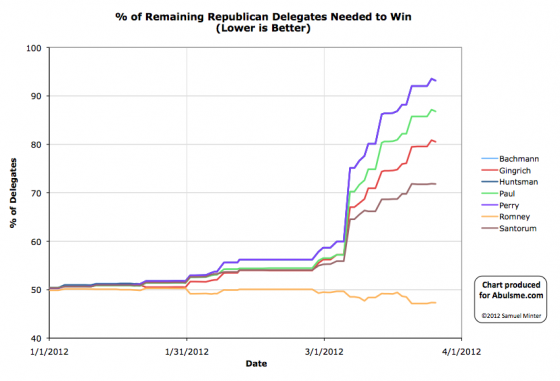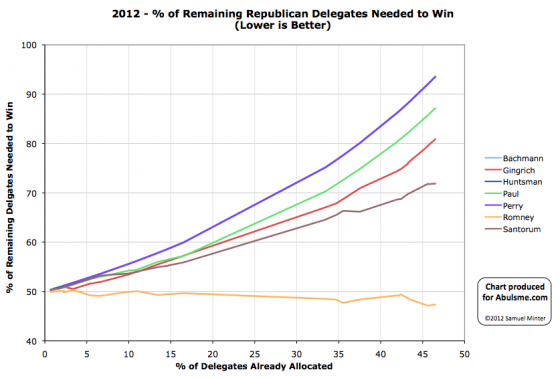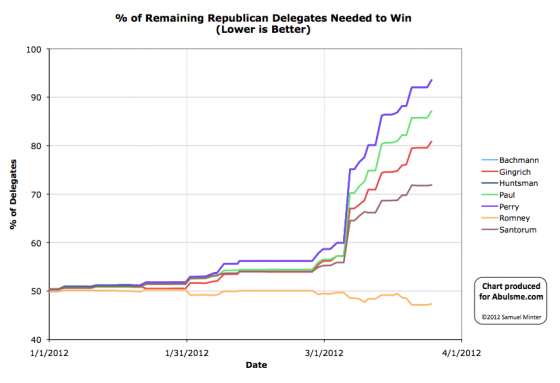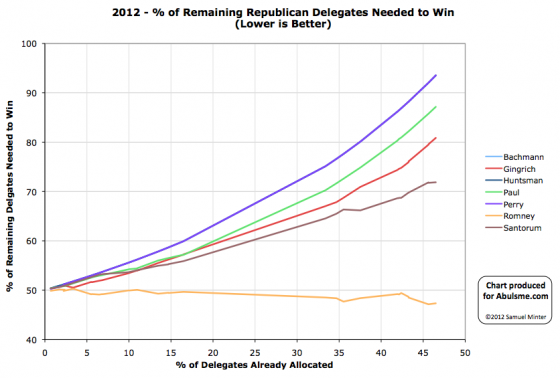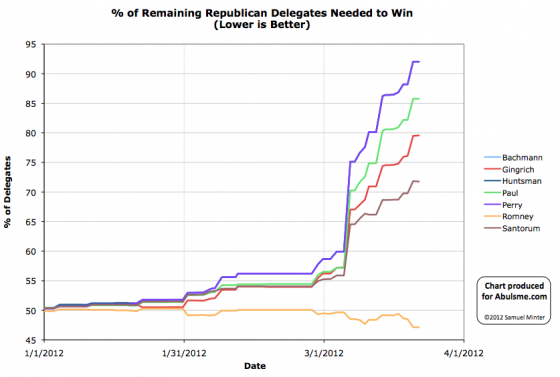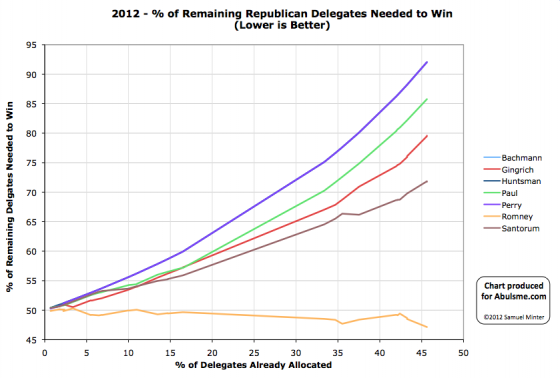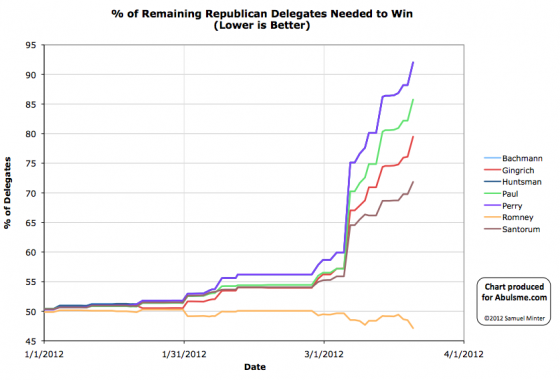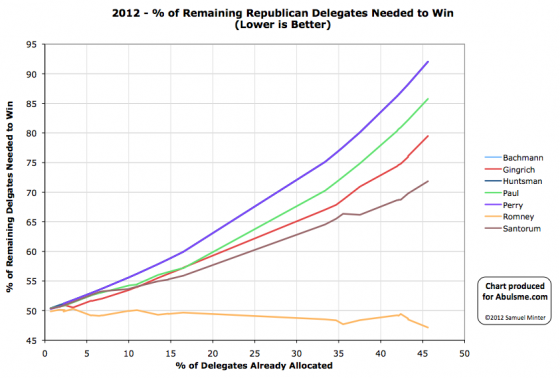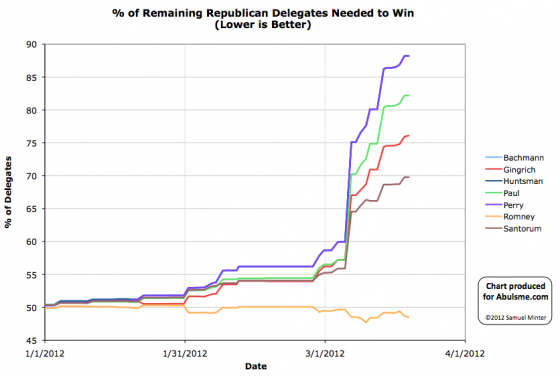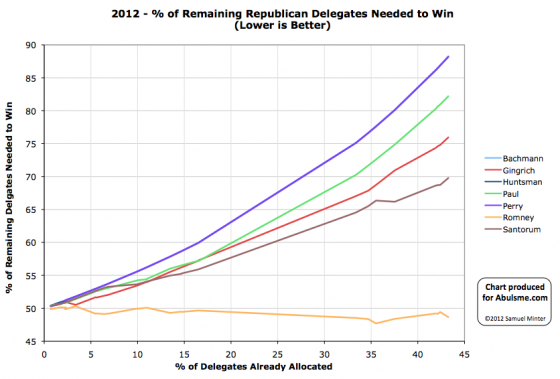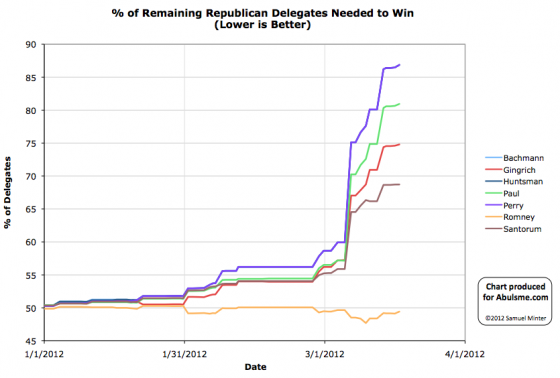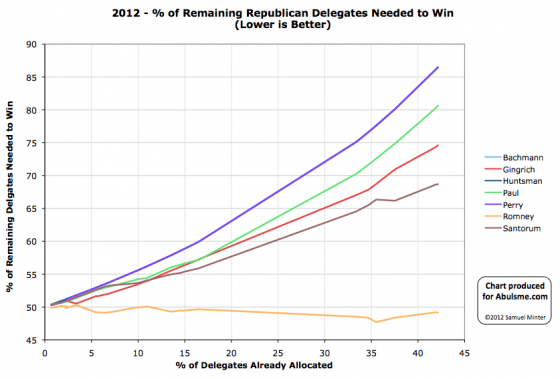In the latest Curmudgeon’s Corner…Sam and Ivan talk about:
Just click to listen now: [wpaudio url=”http://www.abulsme.com/CurmudgeonsCorner/cc20120325.mp3″ text=”Recorded 25 Mar 2012″] or |
 |
|
Charts from the Abulsme.com 2012 Republican Delegate Count Graphs page. When a candidate gets down to 0%, they have cinched the nomination. If they get up past 100%, they have been mathematically eliminated. The first chart is by date, the second is by “% of Delegates Already Allocated”. These numbers include estimates of the eventual results of multi-stage caucus processes which will be refined as the later stages occur. I mentioned yesterday that there was some disagreement on interpretation of the rules for how delegates would be allocated in Louisiana. Green Papers said Santorum 13, Romney 7. @FHQ said Santorum 10, Romney 5 and some uncommitted delegates. My charts use the Green Papers Numbers. Well, since yesterday’s update the Louisiana Republican party weighed in… and it was 10-5, not 13-7. So @FHQ was right and wins that argument. So Green Papers updated their numbers. So, net for today: Santorum -3, Romney -2. This adjusts the numbers slightly, but does not change yesterday’s conclusions. Both Romney and Santorum didn’t do as well as they needed in Louisiana to move toward 1144. So it was still an “everybody loses” contest. Just slightly different numbers. For today’s adjustment, the “% of remaining needed to win” changes like this:
So essentially today is an “everybody wins!” day, simply because there are 5 more delegates available today compared to what was thought to be available yesterday. The race summary remains the same. The non-Romneys are rushing toward mathematical elimination. It would take an event like Romney dropping out to give them an actual shot to get to 1144 before the convention. The most likely scenario remains Romney slowly but surely accumulating delegates and getting to 1144. The possibility of the non-Romneys blocking Romney from getting to 1144 remains remote, but not yet so remote that I’m ready to say outright that it is impossible. Charts from the Abulsme.com 2012 Republican Delegate Count Graphs page. When a candidate gets down to 0%, they have cinched the nomination. If they get up past 100%, they have been mathematically eliminated. The first chart is by date, the second is by “% of Delegates Already Allocated”. These numbers include estimates of the eventual results of multi-stage caucus processes which will be refined as the later stages occur. So, Santorum has a “big win” in Louisiana. But, unfortunately for him, not big enough. Green Papers’ Louisiana Results give 13 delegates to Santorum and 7 to Romney. Gingrich and Paul get nothing. Louisiana also has 26 more delegates that will be determined by other means. (Note that there is some question on interpretation of the delegate rules. @FHQ says 10 Santotum, 5 Romney and some uncommitted delegates. We use Green Papers as our source, and they will update if it becomes clear their interpretation of the rules was wrong.) So with a 13-7 split, that is 65% Santorum. To actually be on a pace to catch up and win, he needed to get 71.8% of the delegates. Didn’t happen. Thus with his “big win” Santorum still moves closer to mathematical elimination. That is some win! Of course, Romney also didn’t get the delegate levels he needed to be on the pace he needs. He needed 47.1% of the delegates. The 35% he gets with his 7 delegates is well below that. So, it’s an “everybody loses!” day. Bottom line is that Louisiana doesn’t change much. The three non-Romney’s are racing inevitably toward elimination. They are just too far behind to catch up absent something as major as Romney dropping out of the race… which I don’t think Romney is thinking about doing at this point. Meanwhile, Romney is in a position to eventually win just by continuing to collect delegates at the same pace he has been. Romney has collected 53% of the delegates so far. If he just keeps chugging at those margins, he’ll get to 1144 eventually. But… the non-Romney’s collectively have gotten 47% of the delegates. If they can up that to 53%, then they can still collect enough delegates to block Romney. 47% to 53% is a big move in a political race. But it is still not out of the realm of the possible. (It is getting close though.) A few big slips by Romney. One of the non-Romney’s doing something really impressive. It COULD happen. It is unlikely though. As I’ve said before here, as it becomes clear that none of the non-Romney’s can actually win, it will be harder and harder for them to actually get delegates. So it is far more likely that the percentage of delegates the non-Romneys can manage will decline as we go forward. “% of remaining needed to win” update based on today’s numbers:
We’re still not quite to the half way mark. 46.5% of the delegates allocated (or estimated) at this point. Next up: DC, Maryland, Wisconsin on April 3rd. All winner take all states, so likely to have a bigger impact. Charts from the Abulsme.com 2012 Republican Delegate Count Graphs page. When a candidate gets down to 0%, they have cinched the nomination. If they get up past 100%, they have been mathematically eliminated. The first chart is by date, on the second chart rather than the date on the x-axis, we show the “% of Delegates Already Allocated” as this better represents the progress through the race. Note that these numbers include estimates of the eventual results of multi-stage caucus processes which will be refined as the later stages occur. Right after the caucuses there, delegates from Alaska were estimated as Romney 8, Santorum 7, Paul 6, Gingrich 3. The district Convention vote is now final, and the estimate changes to Romney 8, Santorum 8, Paul 6, Gingrich 2. So net for the day: Santorum +1, Gingrich -1. (The three superdelegates from Alaska are still up for grabs.) This of course doesn’t substantially change anything. (For the die hards: Santorum’s % of remaining needed to win declines from 71.84% to 71.76%, while Gingrich’s rises from 79.49% to 79.57%.) Charts from the Abulsme.com 2012 Republican Delegate Count Graphs page. When a candidate gets down to 0%, they have cinched the nomination. If they get up past 100%, they have been mathematically eliminated. The first chart is by date, on the second chart rather than the date on the x-axis, we show the “% of Delegates Already Allocated” as this better represents the progress through the race. Note that these numbers include estimates of the eventual results of multi-stage caucus processes which will be refined as the later stages occur. So this looks like it might be it. As I indicated might be a possibility in yesterday’s update, between Romney’s lead growing rapidly in recent polls and Santorum failing to file proper delegate slates everywhere, Romney did indeed do well enough to be moving in the direction of getting to 1144. (In fact he blew away the percentages he needed to get for that.) He is now in the best position he has been in since the race began, and the chances of any brokered convention shenanigans are receding quickly. Lets look at the specifics. With 99% of precincts reporting, Romney has 46.7% of the popular vote in Illinois. But because of the specifics of how delegates are allocated, and Santorum’s failure to have delegate slates everywhere, this translates into getting 42 of the 54 delegates that were up for grabs tonight. That is 77.8% of the delegates. WELL above the 48.5% of delegates he needed to improve his position overall. Santorum gets the other 12 delegates allocated tonight. Gingrich and Paul are shut out and get nothing. Also today the one Puerto Rican superdelegate who had previously endorsed Gingrich decides to echo the election results there, says it is “time to unite” and switches his endorsement to Romney. This makes the totals for today: Romney +43, Santorum +12, Gingrich -1 And looking at “% of remaining delegates needed to win”:
Looking at the charts at the top of this post, between Puerto Rico and Illinois, Romney is finally starting to really drive down this number. His line is finally starting to move downward rapidly. The three non-Romneys continue their race toward mathematical elimination. It won’t be long now. How about the possibilities for blocking Romney? Well, at this point the combined non-Romneys would need to consistently get 52.9% of the remaining delegates in order to be on a pace to stop Romney from getting to 1144. Up to this point the non-Romney’s have managed 46.5% of the delegates. Making the jump from 47% to 53% is a big jump, but still not an unimaginable jump. Perhaps with a few major Romney stumbles in a row? And a few good states in a row? Louisiana maybe? The RCP average for Louisiana has the non-Romneys at 56%. If the popular vote ends up like that, and the delegates parallel the popular vote… Well, yes, Romney may not get what he needs in Louisiana. But after that the calendar starts looking better for Romney again. And with it being essentially 100% clear at this point that none of the non-Romneys have a chance at 1144 (despite what Santorum’s camp was saying recently) and it is all just about blocking Romney, do people continue to vote for candidates who are clearly losing? And perhaps just as importantly, do rich donors still throw millions at candidates who clearly are going nowhere? Probably not. It has taken awhile, but it really does look like Romney is finally starting to put the chances of being blocked in the rear view mirror. I’m not ready to call it impossible quite yet. But it is getting closer to that point and is already very unlikely. We can already say that the non-Romney’s getting it together enough to block Romney would require a major change to how they’ve been doing so far, and a reversal of recent trends. Once Romney’s “% of remaining needed to win” drops below 45% or so we can pretty safely call this a done deal absent a major catastrophe. From then on out, it will just be Romney slowly but surely grinding his way to 1144. But we aren’t there quite yet. Lets see how Louisiana, DC, Maryland and Wisconsin go. (Those last three are winner take all, so April 3rd will be a big day!) This of course does mean that Santorum is now the frontrunner to be the 2016 Republican nominee. (Since Romney will lose to Obama in November according to current polling, and by coming in 2nd this time around, Santorum would be “next in line” on the Republican side.) Too soon? Chart from the Abulsme.com 2012 Republican Delegate Count Graphs page. When a candidate gets down to 0%, they have cinched the nomination. If they get up past 100%, they have been mathematically eliminated. Note that these numbers include estimates of the eventual results of multi-stage caucus processes which will be refined as the later stages occur. A minor update from Georgia today. My primary source, Green Papers, previously had the results from Georgia as Gingrich 54, Romney 19, Santorum 3. This has now been updated to Gingrich 52, Romney 21, Santorum 3. So the net for the day is Romney +2, Gingrich -2. So Romney’s “% of remaining needed to win” drops from 48.7% to 48.5%. (And Gingrich’s rises from 75.9% to 76.1%.) This is a minor change that does not change the state of the race significantly. But since there is an update today, it gives me a chance to modify something I said in the last update based on new information. I had said:
Well. two things. First, recent polls have been moving in Romney’s direction over the last week. The most recent poll as of this writing was a poll from PPP (pdf) that has Romney at 45%. Now, polls predict popular vote, not delegates, and the 48.5% Romney needs is a percentage of delegates, not a percentage of the popular vote. But assuming at least some correlation between popular vote and delegates, those numbers are getting pretty close to each other. Which brings us to… Second, Santorum failed to properly file for delegate slates in some parts of the state. This means that Santorum’s delegate take will almost certainly underperform his performance in the popular vote. This implies that Romney’s delegate take may well overperform his popular vote number. With these two factors together, Romney’s chances of getting to the 48.5% he needs to improve his “% of remaining” number and move closer to the nomination and further away from the scenarios where he doesn’t get to 1144 is much more likely than it looked previously. By this time tomorrow, we should know how that turned out. Chart from the Abulsme.com 2012 Republican Delegate Count Graphs page. When a candidate gets down to 0%, they have cinched the nomination. If they get up past 100%, they have been mathematically eliminated. Rather than the date on the x-axis, we show the “% of Delegates Already Allocated” as this better represents the progress through the race. Note that these numbers include estimates of the eventual results of multi-stage caucus processes which will be refined as the later stages occur. So. Puerto Rico. Romney wins by a huge margin. He got more than 80% of the vote. In second place Santorum got less than 10% of the vote. 50% was the magic number though. The rules for Puerto Rico said that if the winner gets more than 50%, then the delegates are allocated winner take all. So Romney gets all 20 regular delegates from Puerto Rico. (Romney already had 2 of the 3 super delegates from Puerto Rico before tonight, with Gingrich having the remaining super delegate.) Obviously getting 100% of today’s delegates is good for Romney, and bad for everybody else. Duh. Romney’s best position so far was still on March 10th, right after Guam and the Northern Marianas results, but before Kansas and the Virgin Islands. But he moves back toward the nomination, and away from the possibility of not getting to 1144 with this result. The others continue on their rapid path toward mathematical elimination. In terms of the magical “% of remaining delegates needed to win” number:
Next up is Illinois. Romney is ahead in the polls in Illinois, but isn’t over 48.7% in those polls, and of course nobody else is close to the numbers above either. The contest there is a “Loophole Primary” which is a bit odd, but if the delegate results are even close to being proportional to the popular vote result, then we can expect Illinois to be another of the “everybody loses” states where nobody actually gets closer to the nomination in terms of being on pace to win. Add that to Louisiana, which will almost certainly also be an “everybody loses” state and we should wrap up the March contests with basically the same situation we have right now… the 3-non Romney’s with no chance of winning, but Romney still in the zone where being blocked from 1144 is very much still within the realm of possibility. And then we’ll have April. One thing to watch… does Romney remain in the zone where his “% of remaining needed to win” is less than the “% of delegates so far” number. If so, then continuing at the same pace will eventually get him to 1144, just really slowly. If not, then he’ll actually not be on a winning pace, and will have to actually improve his delegate collection rate to win. (Right now Romney has 51.9% of the delegates so far, compared to needing only 48.7% of the remaining delegates to win.)
Chart from the Abulsme.com 2012 Republican Delegate Count Graphs page. When a candidate gets down to 0%, they have cinched the nomination. If they get up past 100%, they have been mathematically eliminated. Note that these numbers include estimates of the eventual results of multi-stage caucus processes which will be refined as the later stages occur. Looks like we finally have final results for all the delegates from Alabama, and what will (maybe?) be a final update for Hawaii as well. All of this from Green Papers of course. In Alabama we add 4 more delegates for Santorum and 2 more for Gingrich. This brings the total for non-Super delegates in Alabama to 22 Santorum, 14 Gingrich, 11 Romney. (Santorum also has one of the three superdelegates for the state, the other two haven’t endorsed yet.) In Hawaii, the update we listed on March 15th is reversed. At that time a delegate was removed from the Paul column and given to Romney. Today that delegate appears to go back into the Paul column. This leaves Hawaii at 9 Romney, 5 Santorum, 3 Paul. So +1 Paul, -1 Romney. So the net for today’s update: Santorum +4, Gingrich +2, Paul +1, Romney -1. This gives changes for the “% of remaining needed to win” number as follows:
Notice that everybody goes up. This is a small number of delegates of course, and pretty small changes to the numbers, but nobody here actually improved their position in terms of being able to get to 1144. Of the net 6 new delegates today, Santorum got 4. So 66.67%. Which is quite a healthy percentage. Overwhelmingly wins the day. But he would have had to have done even better to actually be on a pace to catch up with Romney. Lots of splits like this lead toward nobody getting 1144. But this was a minor update day with a small number of delegates. We’ll see what the real contests get us over the coming week. Chart from the Abulsme.com 2012 Republican Delegate Count Graphs page. When a candidate gets down to 0%, they have cinched the nomination. If they get up past 100%, they have been mathematically eliminated. Rather than the date on the x-axis, we show the “% of Delegates Already Allocated” as this better represents the progress through the race. Note that these numbers include estimates of the eventual results of multi-stage caucus processes which will be refined as the later stages occur. Very minor update today. One new superdelegate from Indiana endorsed Romney. You can barely see the effect on the charts with a microscope. If one must look, Romney’s “% of remaining needed to win” drops from 49.17% to 49.13%. Santorum’s rises from 68.66% to 68.71%. At this stage, one delegate barely budges the numbers. So we await Puerto Rico this weekend for the next big batch of delegates. |
||||
